Introduction: Why Pakistan Is the Hidden Paradise for Trekkers
Adventure Treks Pakistan, home to the majestic Karakoram and Himalayan mountain ranges, offers some of the most thrilling trekking routes in the world. The country’s rugged peaks, tranquil meadows, and glacier-fed rivers make it a dream destination for adventurers. Whether you are scaling the icy slopes near K2 or hiking the lush valleys of Hunza, adventure treks in Pakistan combine beauty, challenge, and culture unlike anywhere else on Earth.
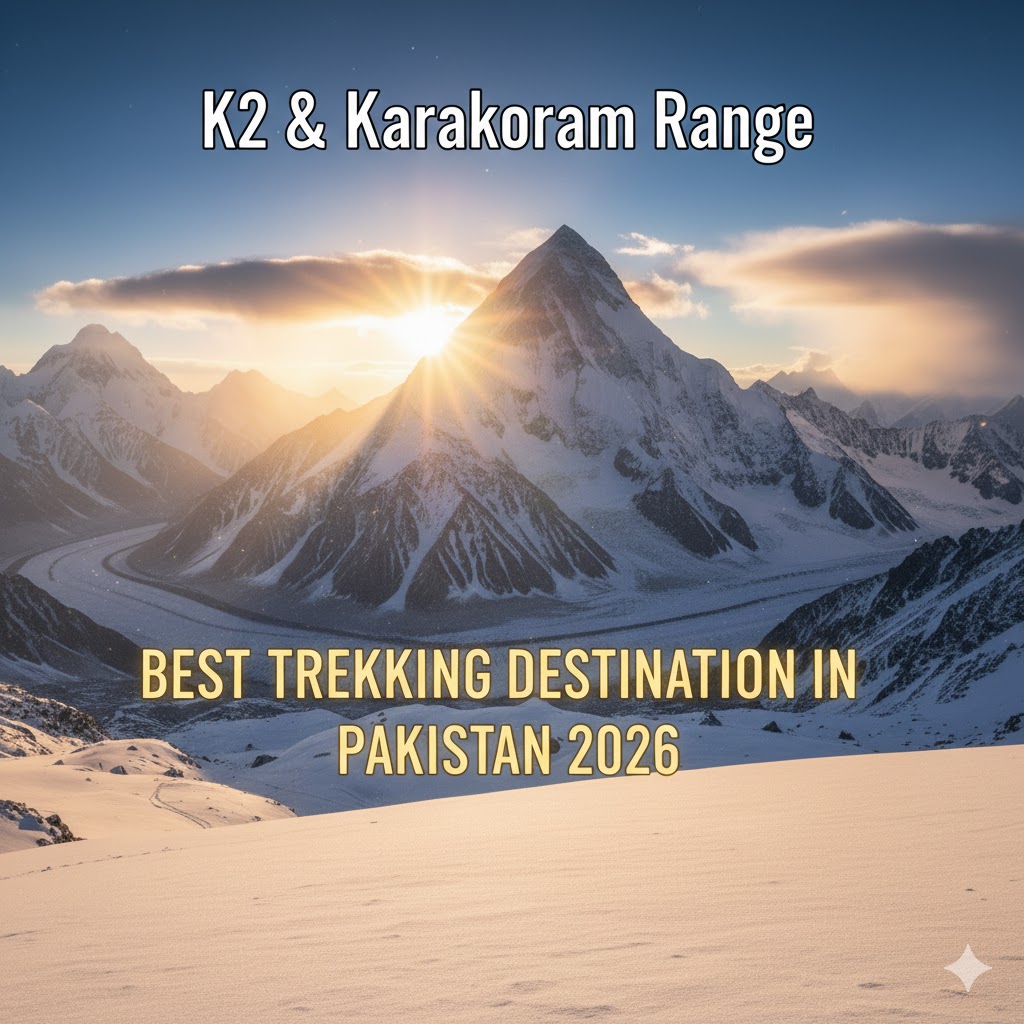
1. K2 Base Camp Trek – The Ultimate Himalayan Challenge
The K2 Base Camp Trek is the crown jewel of trekking in Pakistan, often considered one of the most difficult yet rewarding treks in the world. Situated in the Gilgit-Baltistan region, this trek offers jaw-dropping views of K2 (8,611m), the world’s second-highest peak.
Trekkers pass through icy glaciers like Baltoro and Godwin-Austen, surrounded by giants such as Broad Peak and Gasherbrum. The journey starts from Skardu and takes about 15 days to complete, demanding fitness, patience, and courage.
Highlights:
- Trek Length: ~160 km round trip
- Best Time: June to September
- Significance: Route to the base of the world’s toughest mountain
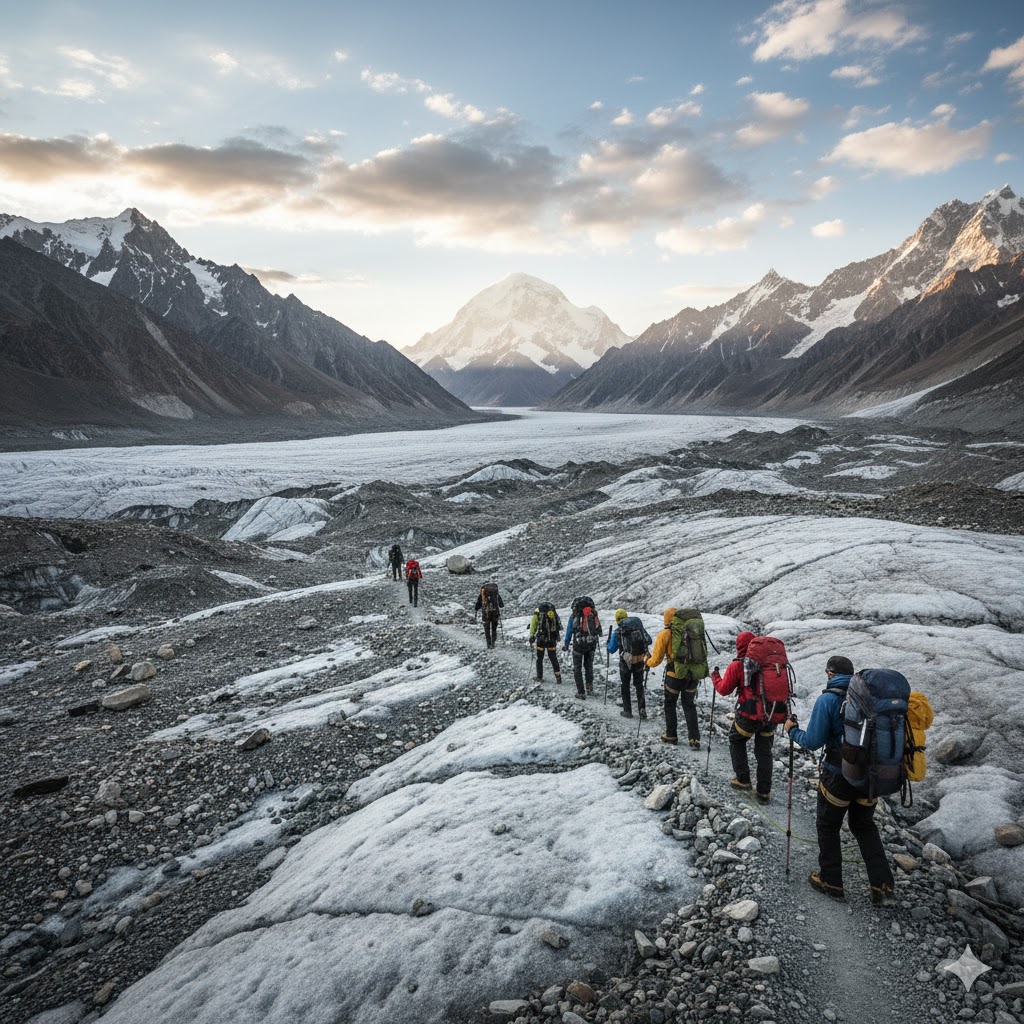
Must See: Explore more about Discover Northern Pakistan Valleys 7 Magical You’ll Love.
Source: Learn more from Pakistan Tourism Development Corporation (PTDC).
2. Fairy Meadows & Nanga Parbat Base Camp – Pakistan’s Paradise on Earth
Tucked under the shadow of Nanga Parbat (8,126m), Fairy Meadows is often called “Heaven on Earth.” It’s one of the most accessible hiking routes in northern Pakistan, yet offers jaw-dropping alpine views. The trek starts with a thrilling jeep ride from Raikot Bridge to Tatu Village, followed by a 3-hour hike to Fairy Meadows.
Trekkers are rewarded with panoramic views of the towering Nanga Parbat — the ‘Killer Mountain’ — and lush meadows dotted with wooden cabins.
Highlights:
- Best Time: April to October
- Difficulty: Moderate
- Experience: Mountain reflection photography, local guesthouses, bonfires
Must See: Check our guide on Discover Valleys.
Source: Read travel updates on TripAdvisor Pakistan.
3. Hunza Valley Trek – Trails Through Time and Tranquility
The Hunza Valley is one of Pakistan’s most beloved trekking destinations, offering a mix of natural beauty and cultural depth. The treks around Karimabad, Passu, and Hopper Glacier give trekkers a chance to experience ancient forts, apricot orchards, and friendly local hospitality.
Popular routes include the Ultar Meadow Trek, Passu Glacier Trek, and Hopper Valley Trek, each revealing a different side of Hunza’s charm.
Highlights:
- Best Time: May to September
- Must-See: Baltit Fort, Eagle’s Nest Viewpoint, Passu Cones
- Tip: Try local Hunza apricot juice after long hikes
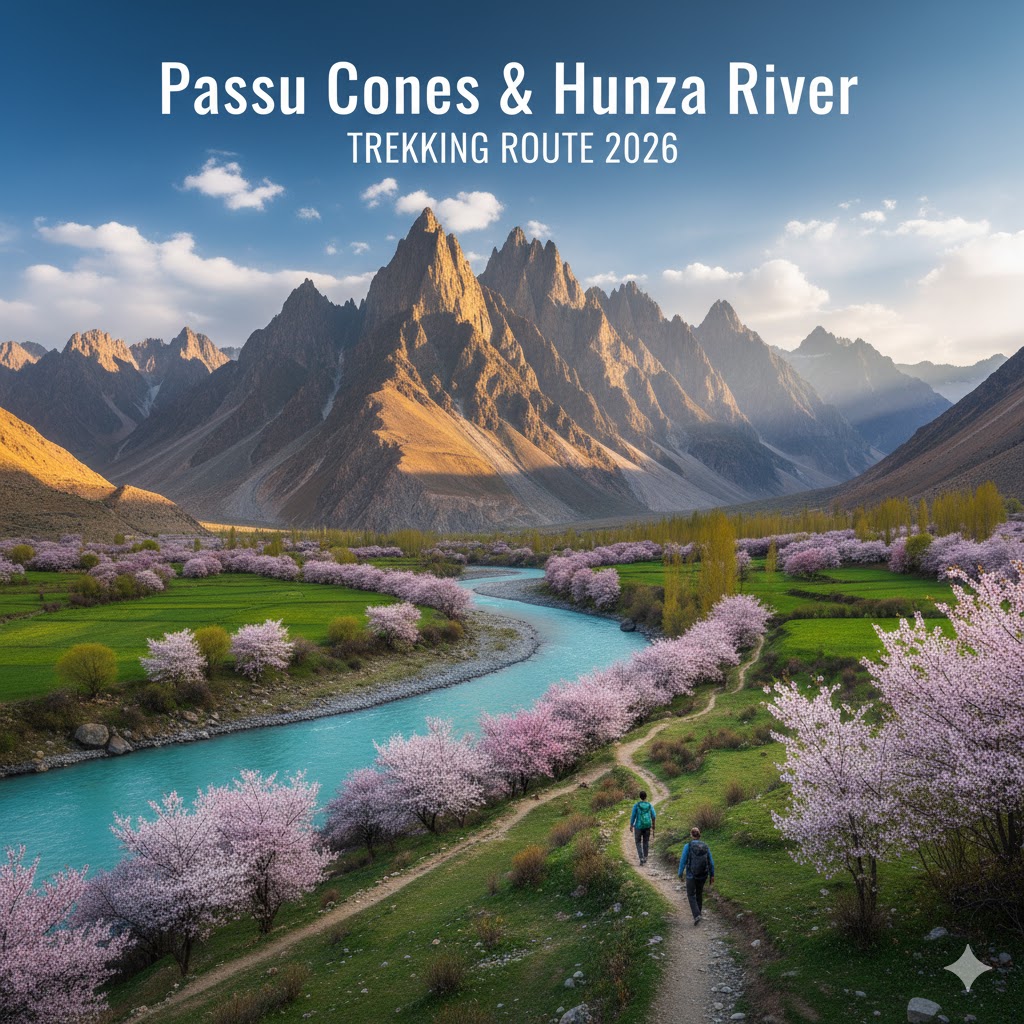
4. Ratti Gali Lake Trek – Kashmir’s Hidden Alpine Treasure
Located in Neelum Valley, Azad Jammu & Kashmir, the Ratti Gali Lake Trek is perfect for trekkers looking for serenity and scenic beauty. The route involves a jeep ride from Dowarian followed by a 3-hour hike through alpine forests and flower-filled meadows.
The sapphire-blue lake, surrounded by snow-capped peaks, looks like a mirror reflecting heaven.
Highlights:
- Altitude: 12,130 ft
- Duration: 1–2 days
- Attraction: Pristine alpine lake and camping under stars
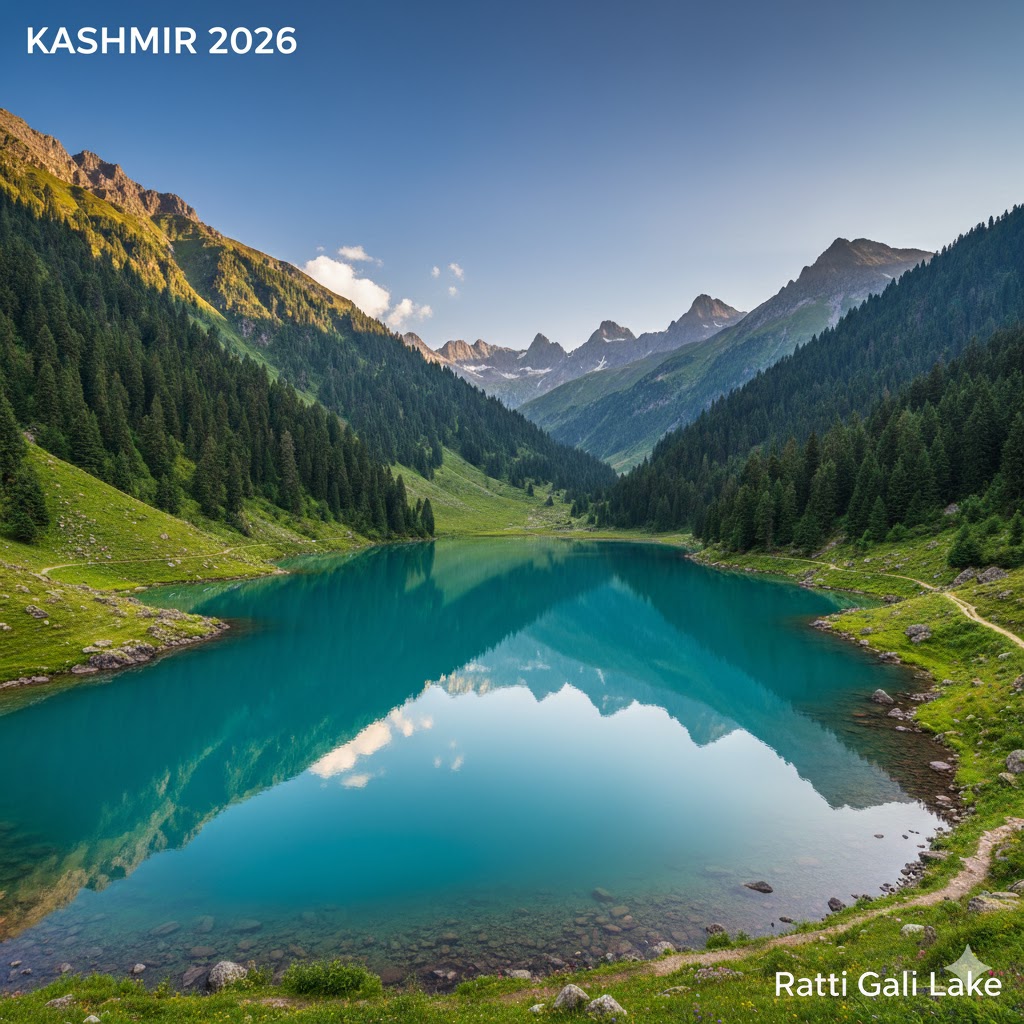
5. Deosai Plains Trek – The Land of Giants
Known as the Roof of the World, Deosai National Park sits at 13,000 feet and is one of the highest plateaus on Earth. This trek combines high-altitude adventure with wildlife exploration — brown bears, golden marmots, and Himalayan ibex can be spotted here.
The lush plains burst into color during summer, with over 200 species of wildflowers blooming across the meadows.
Highlights:
- Best Time: July to September
- Area: 3,000 sq km
- Tip: Camp overnight for a view of the Milky Way like nowhere else
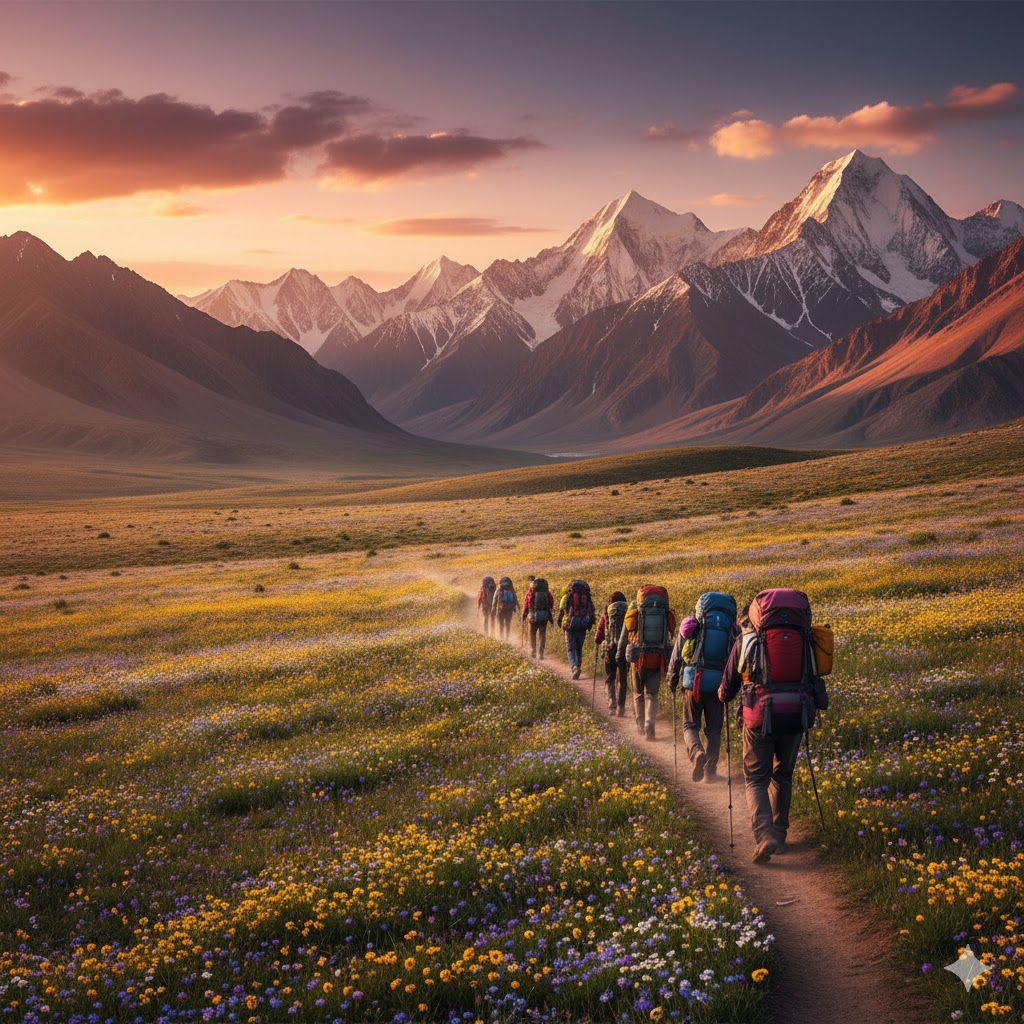
Conclusion – Adventure Treks Pakistan
From the icy routes of K2 to the peaceful trails of Fairy Meadows, adventure treks in Pakistan redefine what it means to explore raw, untouched nature. The country offers trails for all — from seasoned mountaineers to casual hikers seeking cultural connection and scenic escape.
With improved road access, better trekking infrastructure, and warm local hospitality, 2026 is shaping up to be Pakistan’s golden year for adventure tourism.
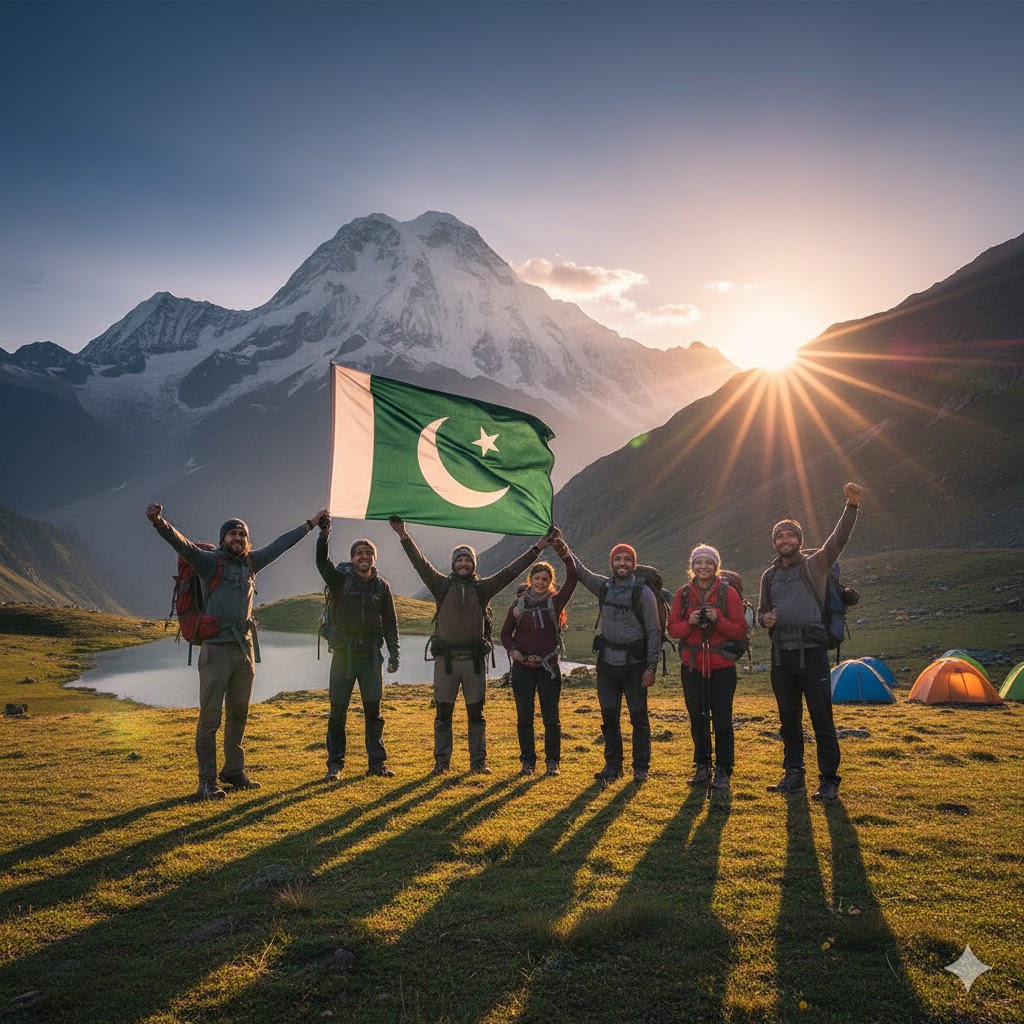
FAQs – Adventure Treks in Pakistan 2026
Q1: What is the best time for trekking in Pakistan?
A: June to September is ideal for northern treks due to clear weather and accessible routes.
Q2: Do I need a permit for K2 Base Camp?
A: Yes, foreign trekkers require a trekking permit from the Gilgit-Baltistan government.
Q3: Is Pakistan safe for foreign trekkers?
A: Absolutely. Northern Pakistan, especially Hunza and Skardu, is known for its safety and hospitality.
Q4: What should I pack for a high-altitude trek?
A: Warm layers, hiking boots, sleeping bag, sunscreen, water purifier, and altitude medication.
6. Naltar Valley Trek – The Hidden Gem of Gilgit
The Naltar Valley Trek is one of Pakistan’s most underrated adventure experiences. Located near Gilgit city, this trek leads travelers through lush pine forests, turquoise lakes, and snow-capped peaks. Naltar is renowned for its vibrant mountain lakes — Satrangi (Seven Color Lake) being the most famous.
Trekkers often encounter local shepherds, natural waterfalls, and peaceful camping spots surrounded by alpine scenery.
Significance: The region is famous for its scenic skiing slope and is home to Pakistan’s oldest ski resort, managed by the Pakistan Air Force.
Tradition: Local families welcome trekkers with chai and yak milk, reflecting the region’s warmth and hospitality.
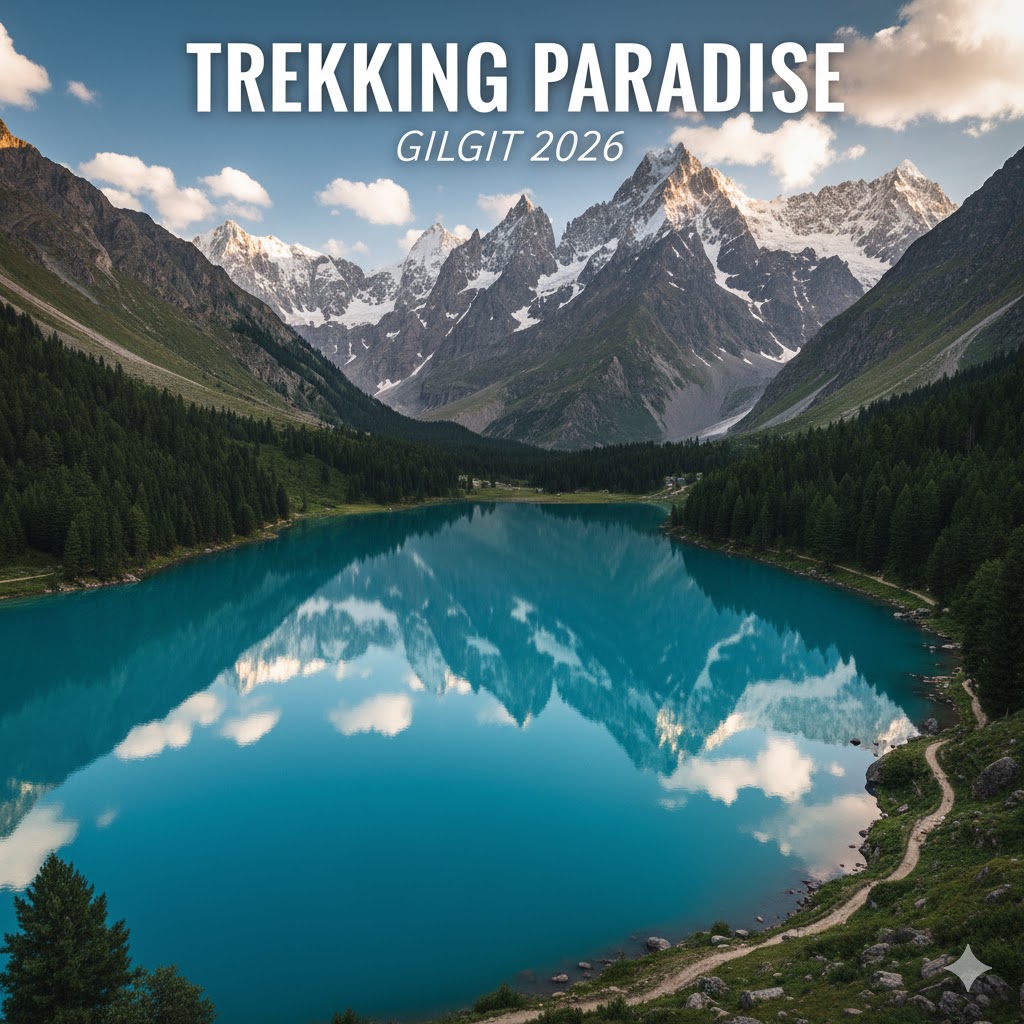
7. Margalla Hills Trail – Urban Adventure in Islamabad
For trekkers near Pakistan’s capital, the Margalla Hills National Park offers a network of scenic trails just minutes from the city center. Popular routes include Trail 3, Trail 5, and the Daman-e-Koh viewpoint, providing panoramic views of Islamabad and Rawalpindi.
This trek is short but challenging, making it perfect for beginners or those training for high-altitude expeditions.
Significance: Serves as the gateway to the mighty Himalayas, offering flora, fauna, and serenity within an urban environment.
Tradition: Locals hike early mornings for spiritual reflection and fitness — blending nature with mindfulness.
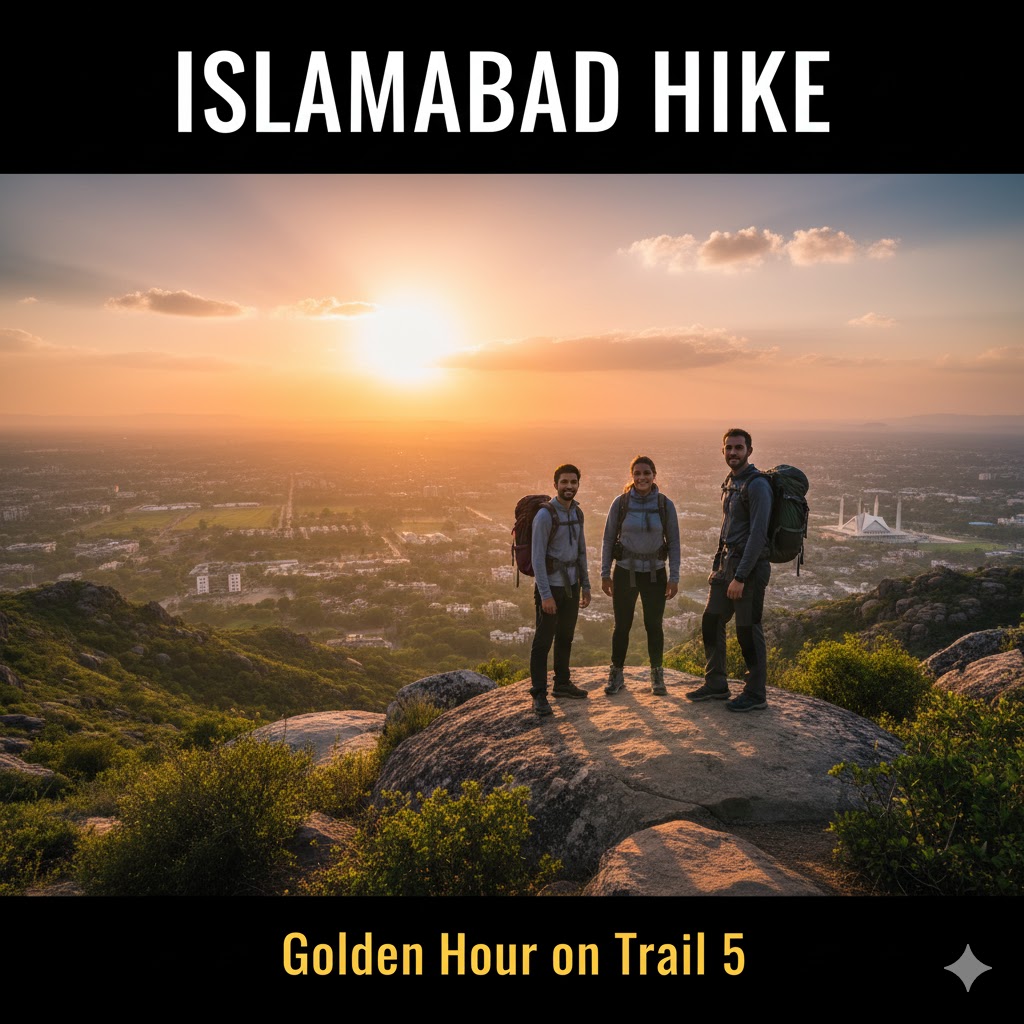
Source: Trail info from Islamabad Wildlife Management Board.
8. Karambar Lake Trek – Pakistan’s Highest Alpine Lake
The Karambar Lake Trek is one of the most remote and breathtaking routes in northern Pakistan. Located between Ishkoman Valley (Gilgit-Baltistan) and Broghil Valley (Chitral), the lake sits at an altitude of 14,121 ft, making it one of the highest alpine lakes in the world.
The trek is a blend of raw adventure, isolation, and natural wonder. Trekkers encounter nomadic Wakhi herders, blooming pastures, and untouched wilderness rarely seen by outsiders.
Significance: Known for its crystal-clear waters with an exceptional reflection of the Hindu Kush peaks.
Tradition: Local shepherds celebrate a summer gathering near the lake, offering goat milk and singing folk Wakhi songs.
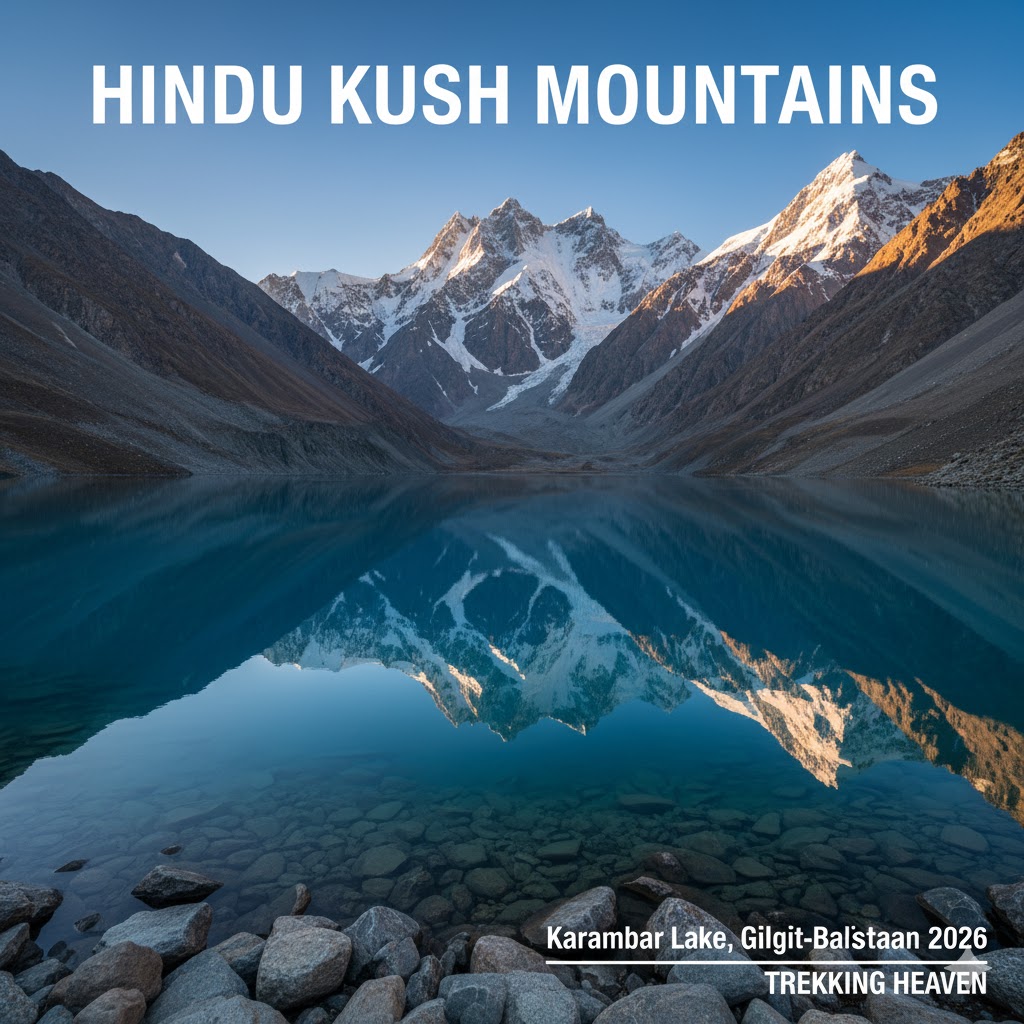
Source: For trekking logistics, visit Backpackers Club Pakistan.
9. Malam Jabba Snow Trek – Winter Adventure for All Ages
Located in the Swat Valley, Malam Jabba is Pakistan’s top winter sports resort. In summer, its trails turn into gentle trekking paths winding through alpine forests and ski slopes. In winter, it becomes a hub for snowshoeing, skiing, and short treks surrounded by snow-covered pine trees.
Significance: One of the few destinations in Pakistan where you can trek and ski in the same location.
Tradition: Winter carnivals are held each January, featuring local music, snow sports, and cultural shows.
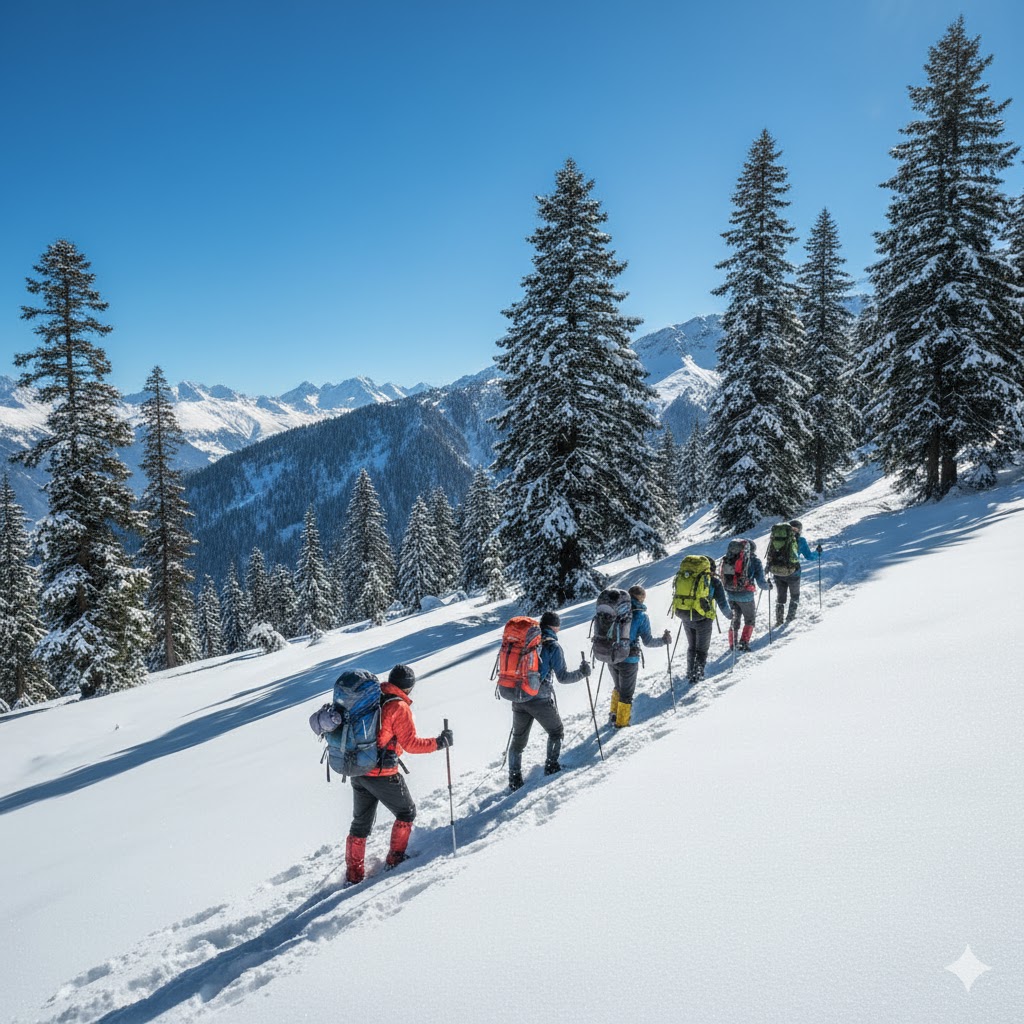
Source: Read more on Khyber Pakhtunkhwa Tourism Department.
10. Passu Glacier & Batura Glacier Trek – Hunza’s Frozen Giants
Ending the list on a grand note, the Passu and Batura Glacier Treks in Hunza are among the most scenic and accessible glacier treks in the Karakoram. The route takes trekkers past the iconic Passu Cones, serene rivers, and vast ice fields.
Despite the glacier terrain, this trek is moderate in difficulty, making it popular among both local and international hikers.
Significance: Batura Glacier is the fifth-longest glacier outside the polar regions — 56 km long!
Tradition: The Hunza people share tales of mountain spirits and legends of survival tied to these glaciers.
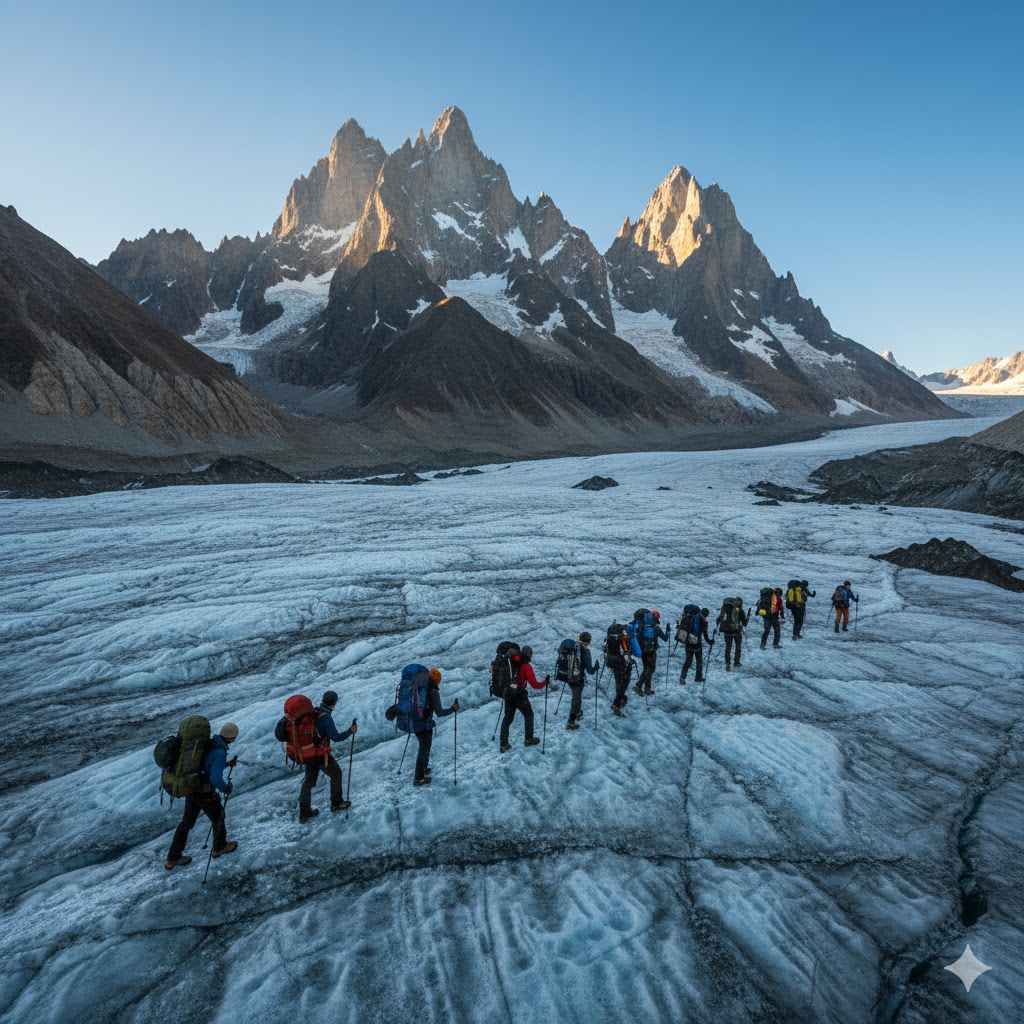
Source: For mountaineering updates, visit Alpine Club of Pakistan.
Bonus: Tips from Local Instructors and Trekking Experts
To make your adventure treks in Pakistan safer and more rewarding, here’s guidance from local trekking instructors and guides:
- Train Physically: Focus on endurance, stair climbing, and daily walks before arrival.
- Acclimatize: Spend 1–2 days in Skardu or Hunza before starting high-altitude treks.
- Hire Local Porters: They know the terrain best and your support helps local communities.
- Stay Eco-Friendly: Carry reusable bottles and avoid littering — most trails are pristine.
- Respect Local Culture: Ask permission before taking photos in villages, especially during religious events.
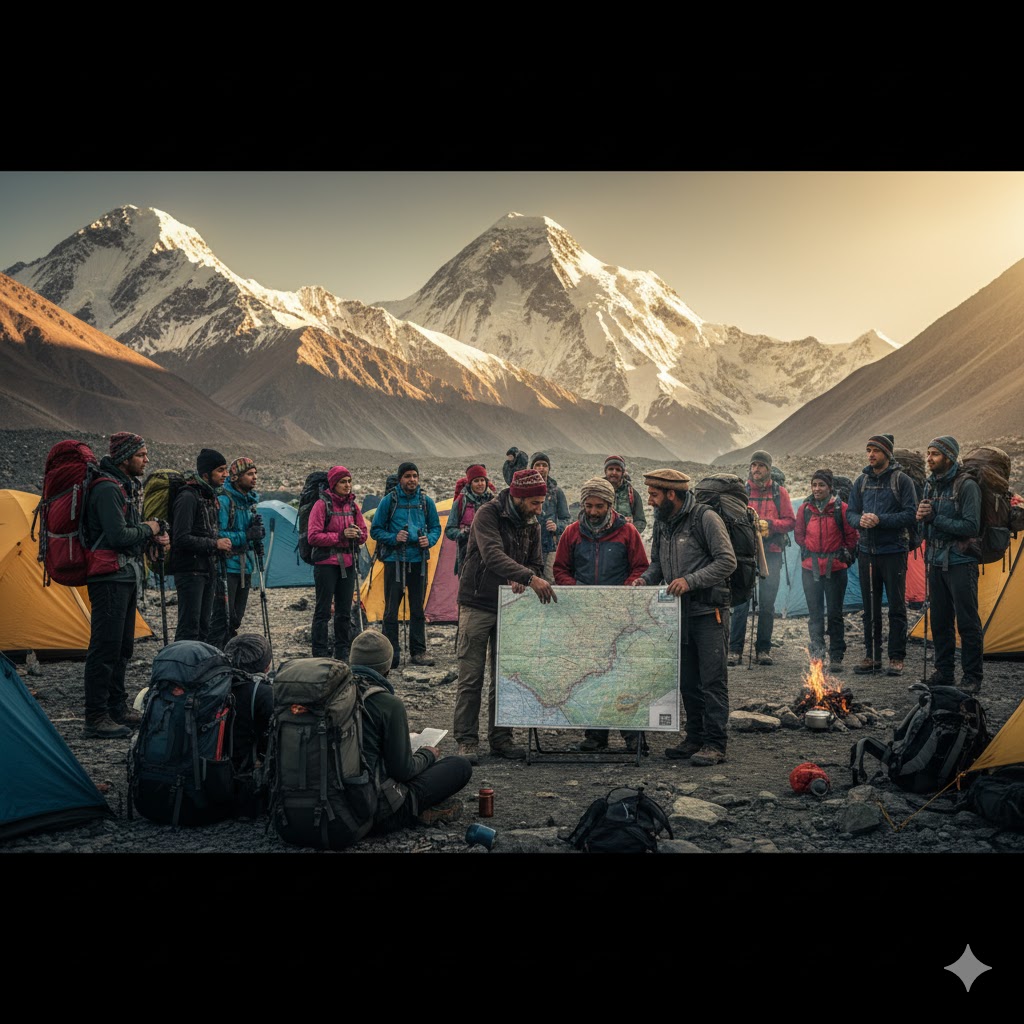
Best Time & Weather for Adventure Treks in Pakistan (2026)
Pakistan’s diverse geography—from the Karakoram glaciers to the southern plains—creates distinct trekking seasons. The best time for adventure treks in Pakistan depends on region and altitude.
- May to September (Summer–Autumn): Ideal for northern treks like Fairy Meadows, K2 Base Camp, and Hunza glaciers. During these months, trails are open, wildflowers bloom, and visibility is crystal clear.
- October to April (Winter–Spring): Suitable for southern and low-altitude treks such as Margalla Hills or Hingol National Park.
Trekkers planning high-altitude expeditions should monitor snowmelt levels and glacier movement reports, especially around Baltoro and Passu.
Significance: Weather stability during June–August allows longer trekking windows in the Karakoram and Hindukush.
Tradition: Locals celebrate the arrival of spring (Nowruz) with regional fairs and dances, marking the unofficial start of trekking season.
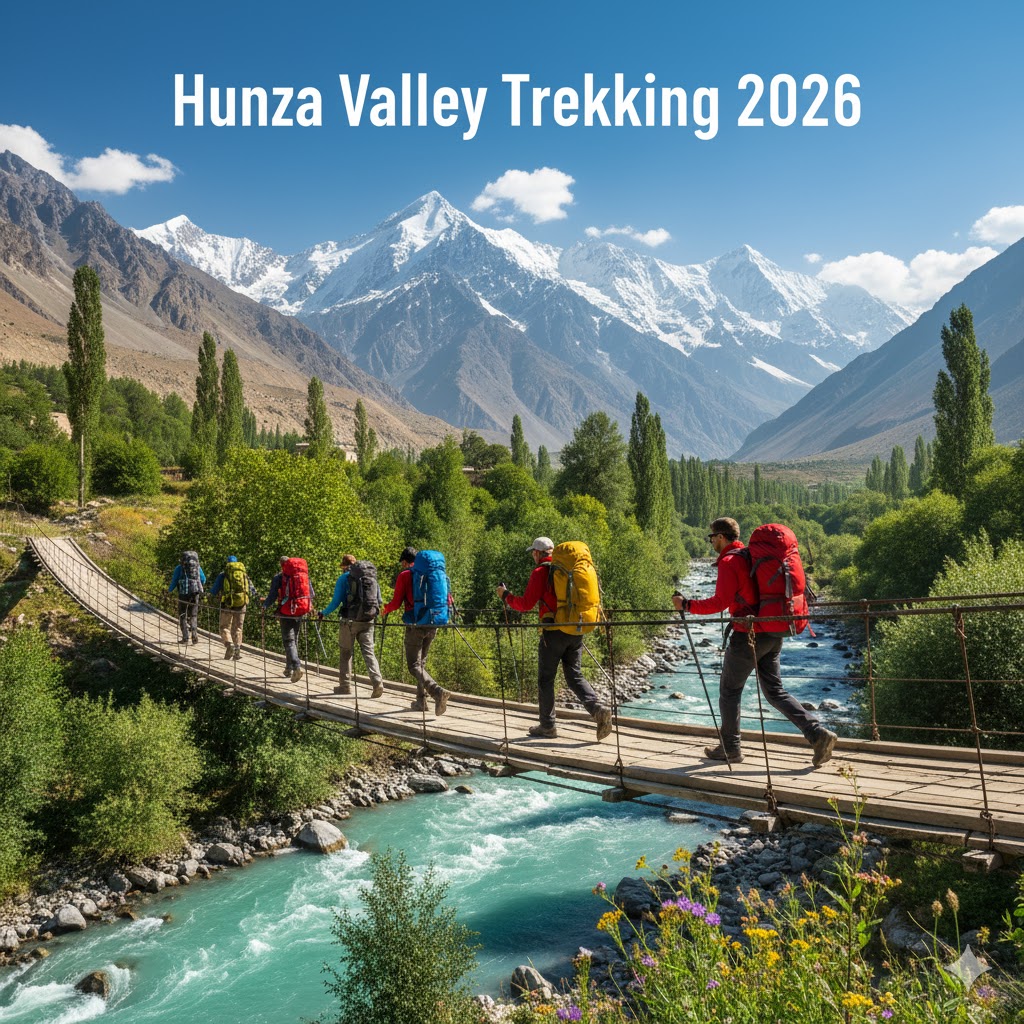
Cultural Experiences During Treks
What makes adventure treks in Pakistan truly unique is how each trail immerses travelers in local cultures that date back centuries. Whether you trek through Hunza’s Ismaili villages, Skardu’s Balti settlements, or Chitral’s Kalash valleys, you’ll witness remarkable traditions.
Trekkers are often welcomed into homes for chai (tea) and traditional meals such as chapshuro, mantu, or yak butter tea. Music and storytelling around campfires are part of the mountain culture.
Significance: Pakistan’s trekking regions are living museums of ancient Silk Route cultures.
Tradition: Local porters sing folk songs that echo through the valleys—these “mountain melodies” symbolize courage and unity.
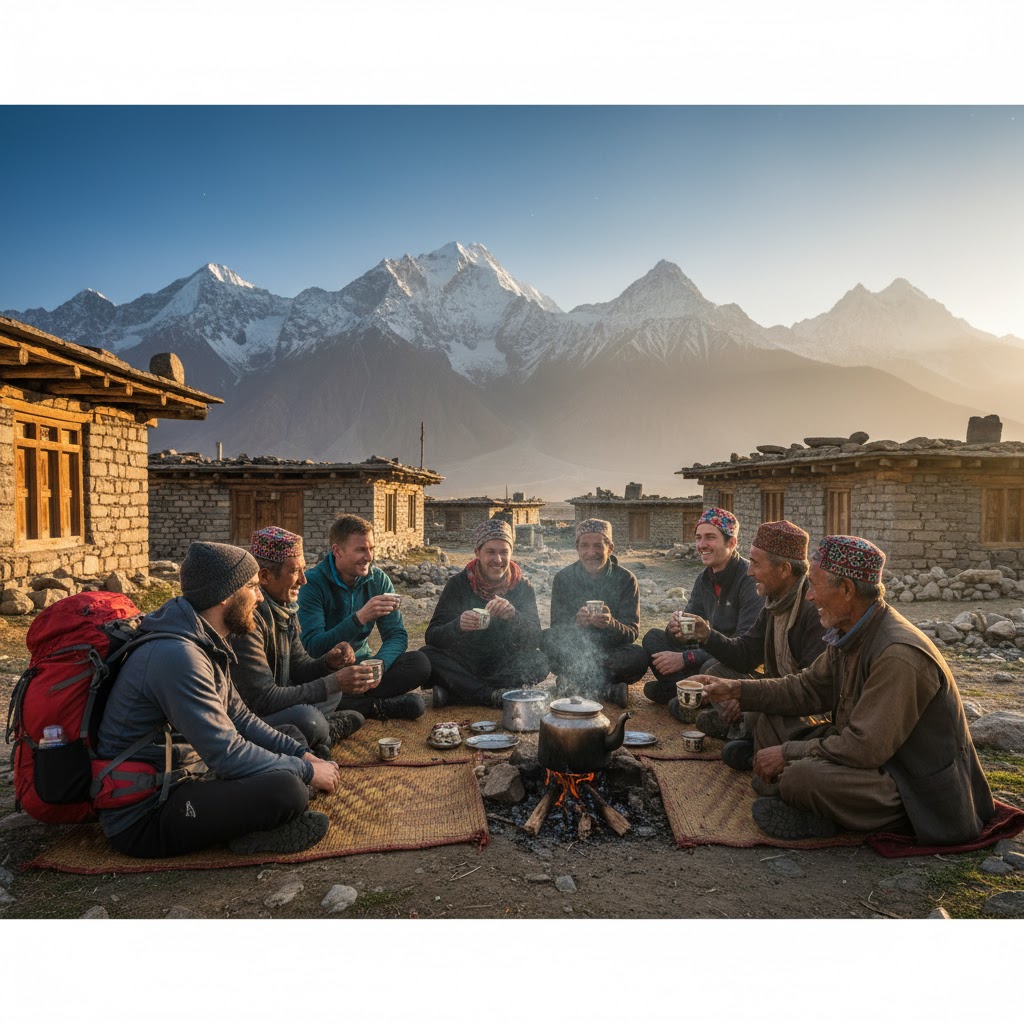
Photography Hotspots & Hidden Viewpoints
Pakistan’s treks are a paradise for photographers, offering everything from glacial reflections to star-studded skies.
Top Photography Hotspots:
- Fairy Meadows Viewpoint: Sunrise over Nanga Parbat.
- Deosai National Park: Wildflowers and Himalayan brown bears.
- Passu Cones: Sunset with reflections in the Hunza River.
- Baltoro Glacier: Towering peaks of Trango Towers and Broad Peak.
- Malam Jabba: Snow trails and pine forests in golden hour light.
Significance: Many adventure photographers consider Pakistan the next frontier for outdoor visual storytelling.
Tradition: Locals often join photos holding their traditional woolen caps or flags, symbolizing unity and pride.
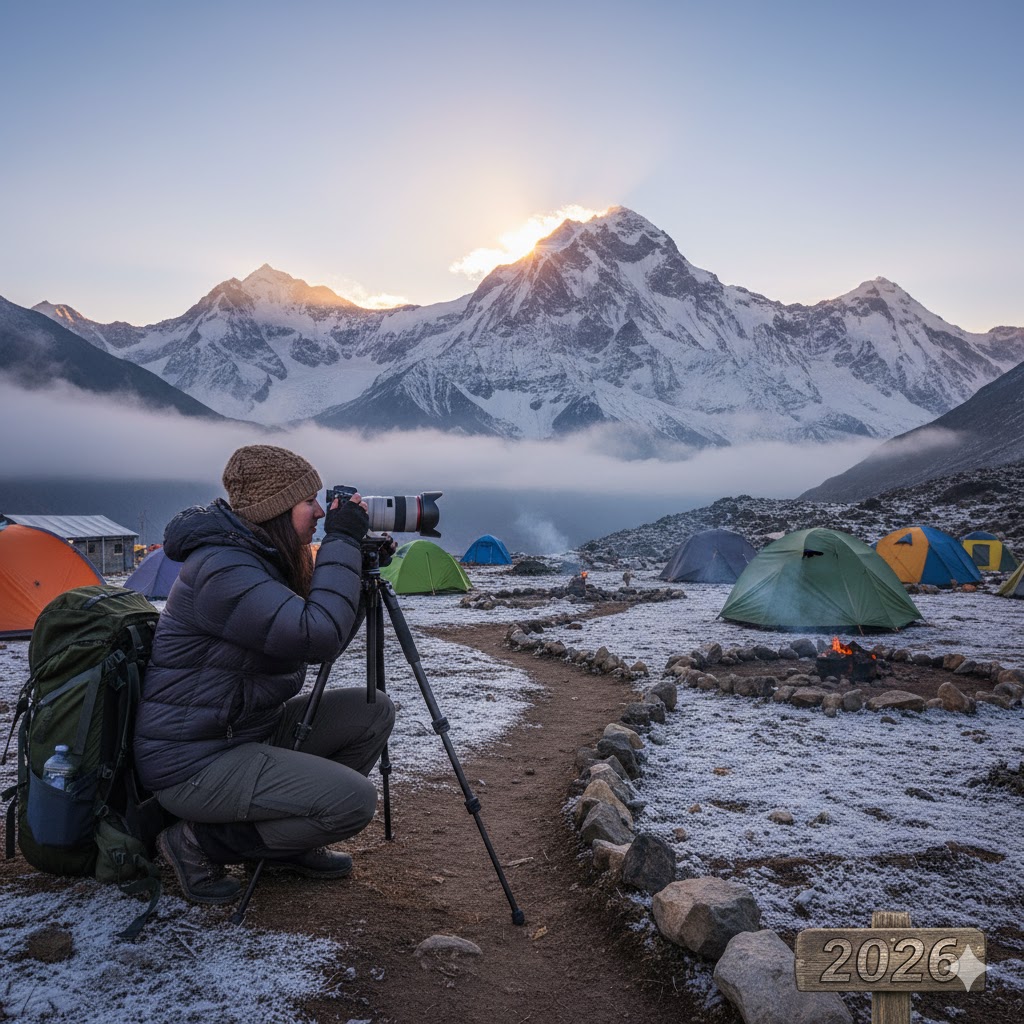
Essential Gear Checklist for Adventure Treks Pakistan (2026)
Before setting off, trekkers should pack efficiently for Pakistan’s diverse conditions. A properly packed rucksack can make the difference between a smooth adventure and a difficult one.
Trekking Essentials:
- 40–60L backpack
- Waterproof hiking boots & gaiters
- Warm sleeping bag (rated -10°C or below)
- Trekking poles & gloves
- Portable stove or heat pack
- Solar power bank
- Reusable water filter bottle
- First aid kit with Diamox for altitude
- Lightweight down jacket & thermal wear
Significance: Proper gear ensures safety during unpredictable weather and long glacier crossings.
Tradition: Locals often wrap woolen scarves called “chadar” for warmth and cultural identity.
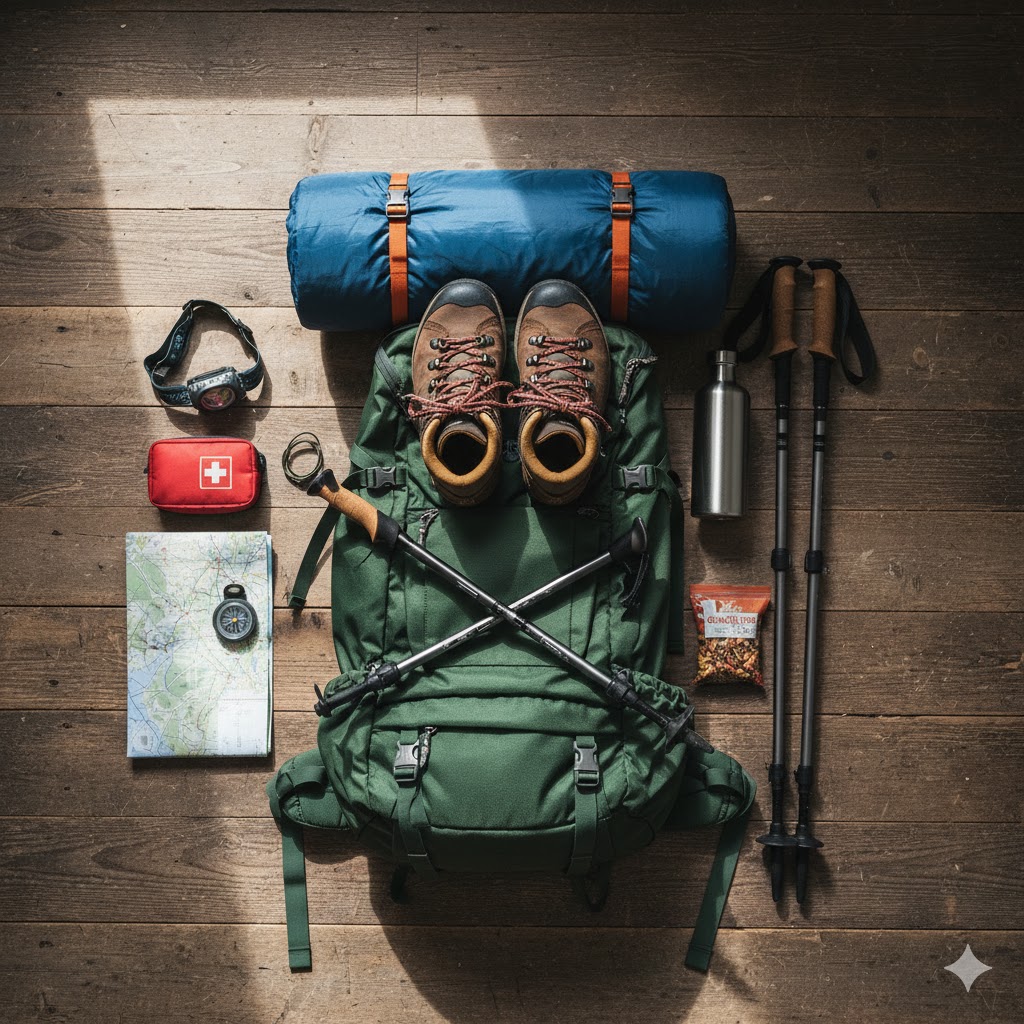
Eco-Trekking & Sustainable Travel in Pakistan
Eco-friendly trekking is now a growing movement across Pakistan. Many national parks like Deosai, Khunjerab, and Hingol have introduced Leave No Trace policies. Trekkers are encouraged to minimize plastic use, carry waste bags, and support local homestays over commercial hotels.
Significance: Sustainable trekking helps protect fragile alpine ecosystems and supports local communities.
Tradition: Mountain communities follow ancient eco-practices — they plant trees after festivals and avoid cutting sacred juniper groves.
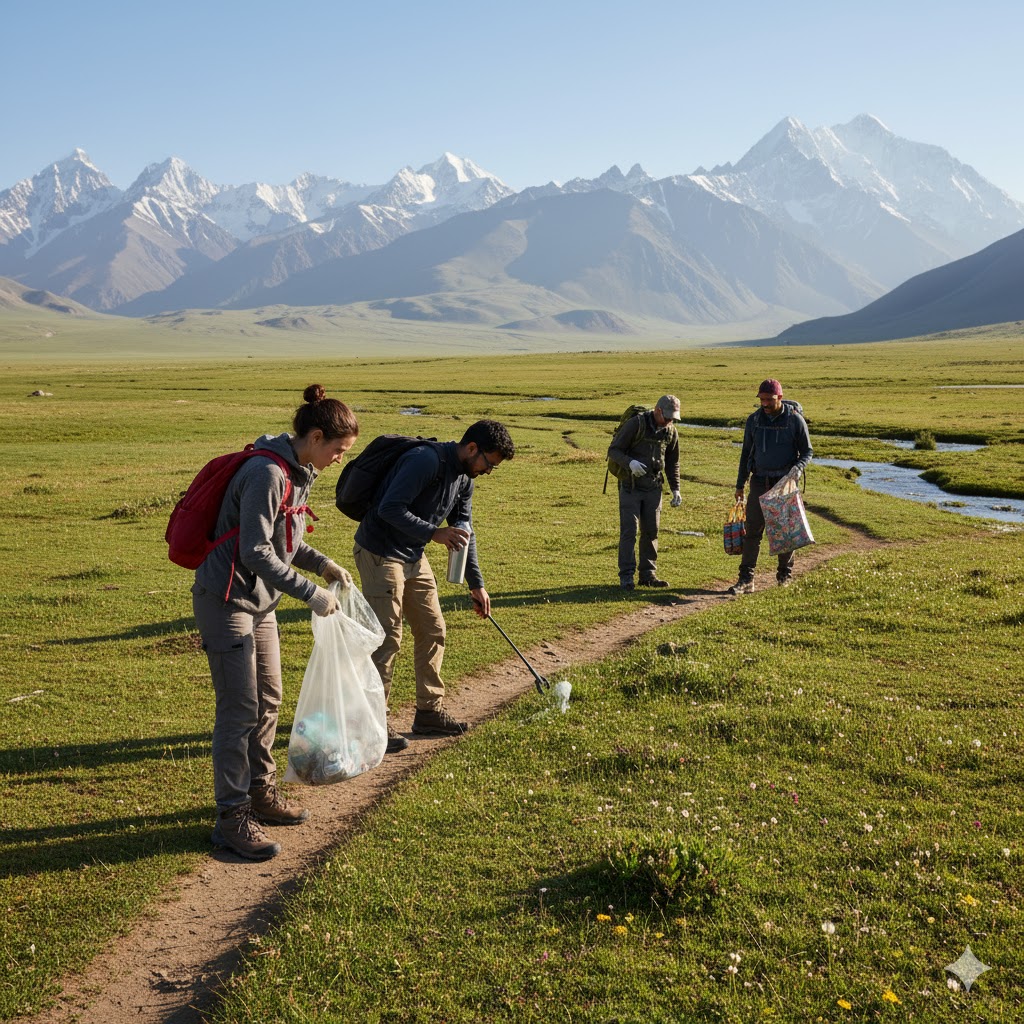
Regional Trekking Maps & Highlights (2026)
To truly understand the adventure treks in Pakistan, you must explore its three primary mountain regions: Karakoram, Himalaya, and Hindukush. Each range has its unique terrain, altitude, and cultural heritage — offering every kind of trekker something distinct.
1. Karakoram Range (Gilgit-Baltistan)
The Karakoram is home to the world’s highest concentration of 8,000-meter peaks, including K2, Broad Peak, and Gasherbrum I & II. Trekkers often describe this region as the “Roof of the World.”
Popular Routes:
- Baltoro Glacier Trek to Concordia: A mesmerizing 14-day expedition where trekkers walk alongside towering ice formations and pass by Trango Towers — a climber’s paradise.
- Hoper Glacier & Rush Lake Trek: Known for its bright turquoise lake sitting at 4,700m, surrounded by snow peaks.
- Passu Glacier Trek: Offers breathtaking views of the iconic Passu Cones and Hunza River valley.
Significance: Karakoram treks are among the most challenging yet rewarding on Earth.
Tradition: Local Balti guides perform a “summit blessing” ritual before major expeditions.
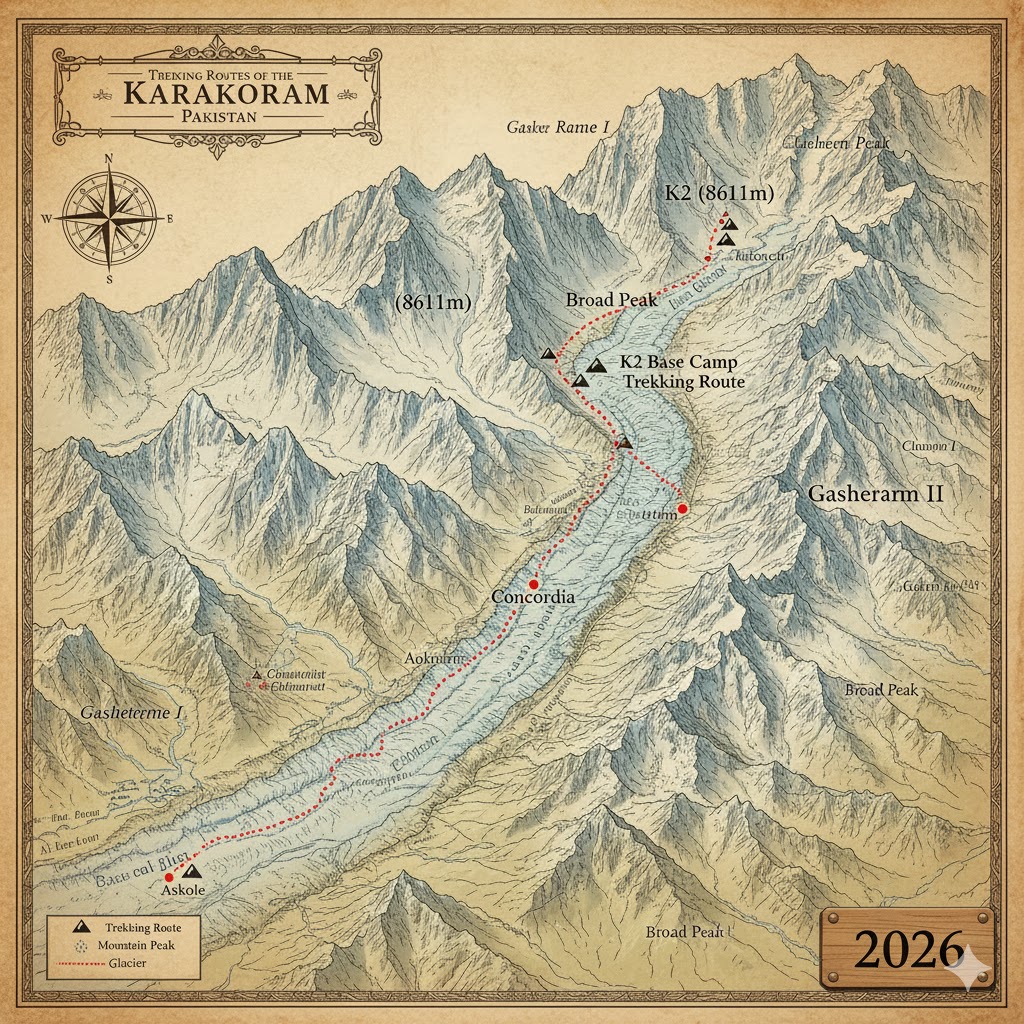
Source: Trail data and permits from Gilgit-Baltistan Tourism Department.
2. Himalayan Range (Northern KPK)
Stretching across Kaghan, Naran, and Neelum valleys, the Pakistan Himalaya is greener and softer compared to the Karakoram’s rugged terrain.
Popular Routes:
- Fairy Meadows to Nanga Parbat Base Camp: A world-famous trek offering unparalleled views of the “Killer Mountain.”
- Ratti Gali Lake Trek: A scenic trail through alpine meadows ending at a crystal-blue lake.
- Dudipatsar Lake Trek: Known as the “Queen of Lakes,” surrounded by snow-capped mountains even in midsummer.
Significance: Perfect for moderate trekkers and nature photographers.
Tradition: Locals from Naran and Kaghan host “summer meadow picnics” where folk music fills the valleys.
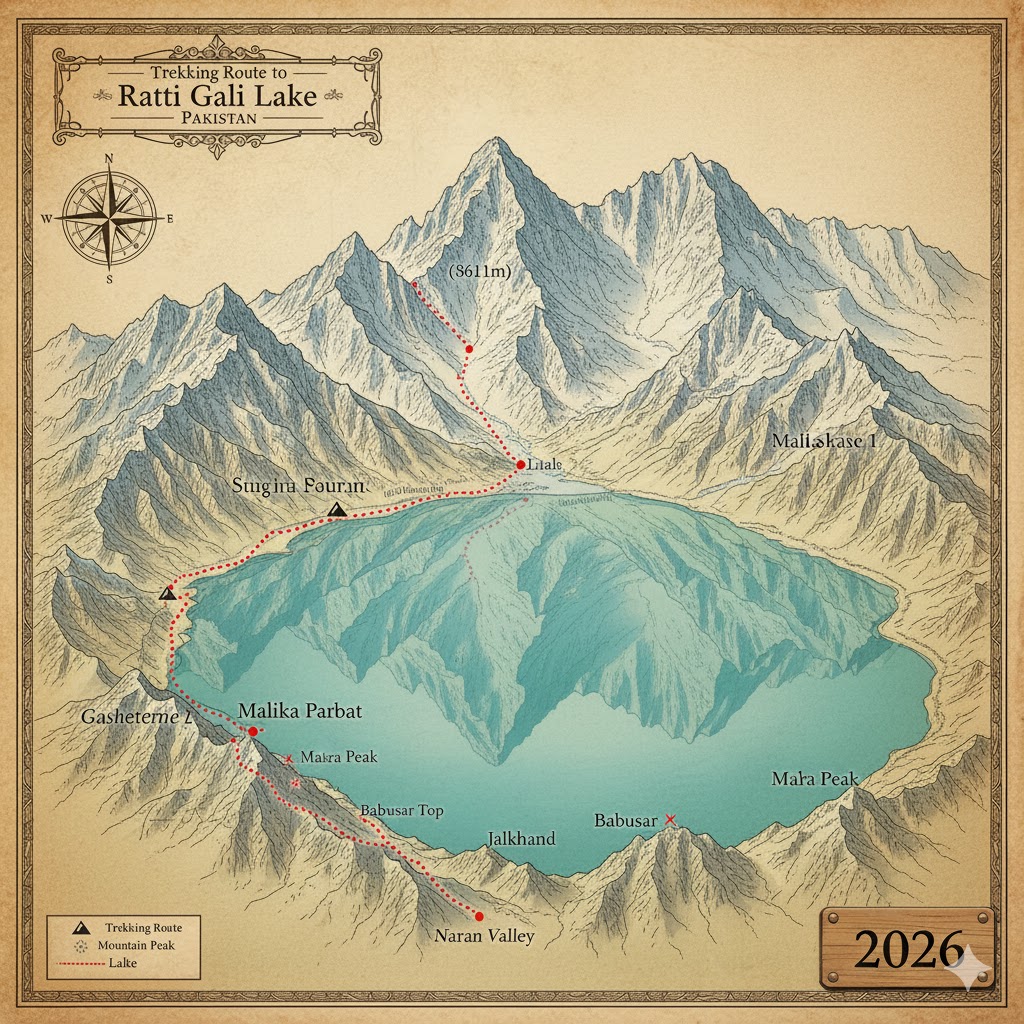
Source: Regional tourism updates from Khyber Pakhtunkhwa Tourism.
3. Hindukush Range (Chitral & Kalash)
One of the least explored trekking destinations, the Hindukush Mountains offer a blend of history and adventure. Home to the Kalash Valleys, this region is rich in ancient customs and untouched beauty.
Popular Routes:
- Tirich Mir Base Camp Trek: Takes you to the foot of the highest peak in the Hindukush range (7,708m).
- Rumbur & Bumburet Valley Trails: Cultural treks through the colorful Kalash villages, famous for their spring and autumn festivals.
- Broghil Pass Trek: A wild frontier trail leading towards the Wakhan Corridor.
Significance: Ideal for cultural immersion and remote wilderness trekking.
Tradition: Kalash people greet trekkers with dance and locally brewed walnut wine during festivals.
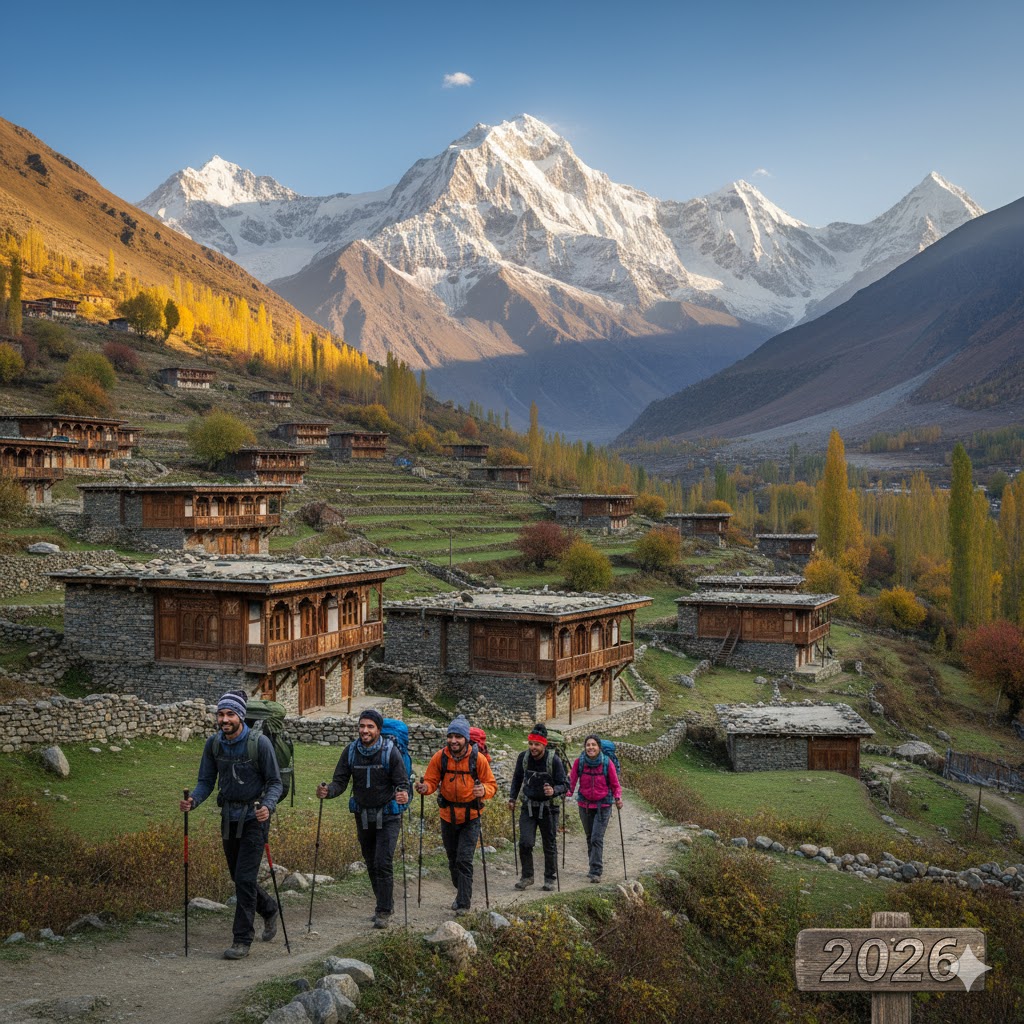
External Link: Cultural preservation details at UNESCO Pakistan.
Budget Breakdown & Trekking Costs (2026 Update)
While Pakistan is one of the most affordable adventure destinations, proper planning ensures safety and comfort. Here’s a cost overview for 2026:
| Expense Type | Budget Traveler (USD) | Mid-Range (USD) | Luxury Trek (USD) |
|---|---|---|---|
| Local Flights (Islamabad–Skardu/Hunza) | $80–$150 | $200 | $400+ |
| Trekking Permits & Fees | $50–$100 | $120 | $200 |
| Accommodation (per night) | $10–$25 | $40 | $120+ |
| Porter/Guide Charges (daily) | $15–$25 | $35 | $60+ |
| Meals (daily) | $10 | $25 | $50 |
| Gear Rental & Transport | $30–$60 | $100 | $200+ |
| Average Total (10–14 Days) | $700–$1200 | $1500–$2500 | $4000+ |
Significance: Pakistan’s affordability compared to Nepal or Bhutan attracts increasing numbers of international trekkers.
Tradition: Many local guides operate family-run guesthouses that reinvest profits into community schools and medical aid.
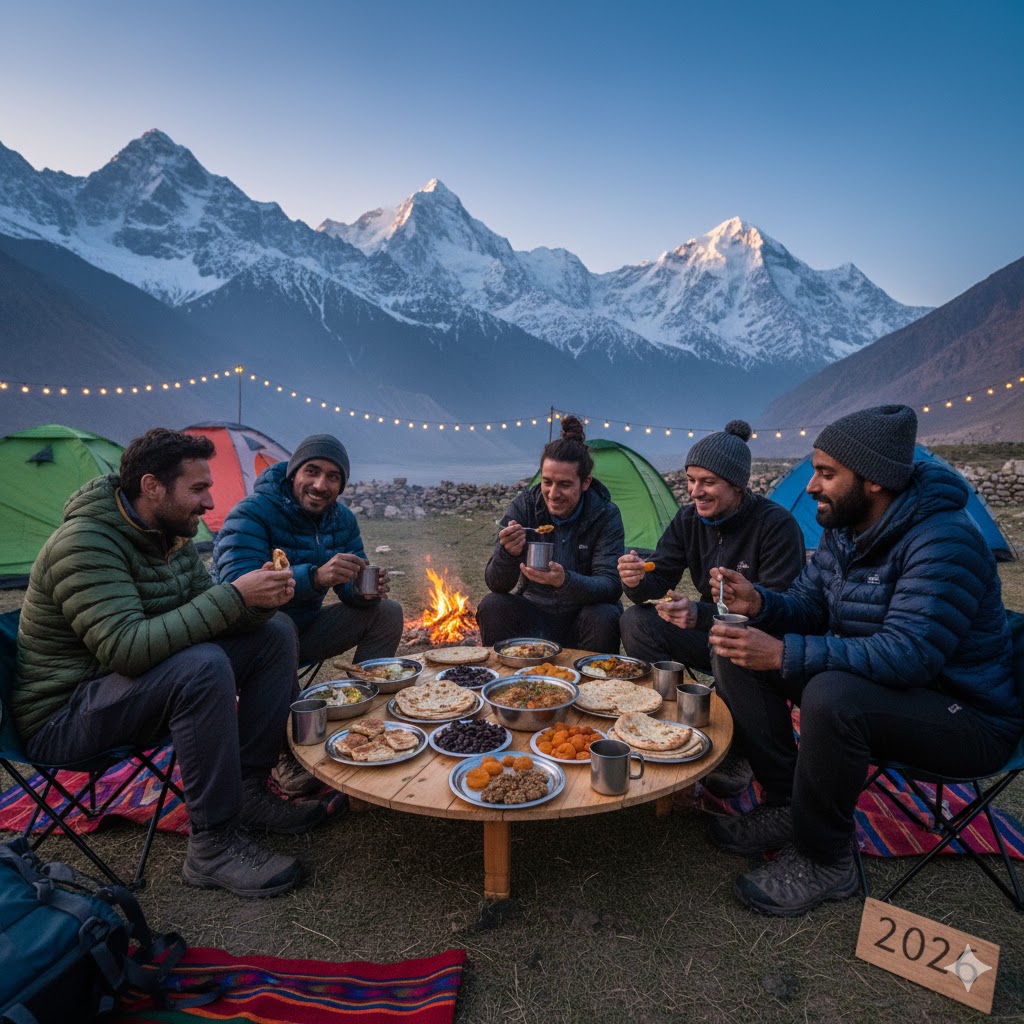
Source: Visa and permit costs via Pakistan Online Visa Portal.
Local Trekking Agencies & Permits
Trekkers planning long routes (especially K2 or Concordia) require registration with the Gilgit-Baltistan Council and must be accompanied by a licensed guide.
Top Registered Trekking Operators (2026):
- Karakoram Explorers (Skardu)
- Traverse Pakistan (Islamabad)
- Wild Tracks Adventure (Hunza)
- Pakistan Alpine Club Certified Guides
Required Permits:
- Passport copy + visa page
- Trekking application form (from Tourism Office)
- Insurance certificate
- Liaison officer assignment for restricted areas
Significance: Permits ensure rescue access and trail safety monitoring.
Tradition: Guides often perform a small “dua” (prayer) before every long journey, seeking safe passage.
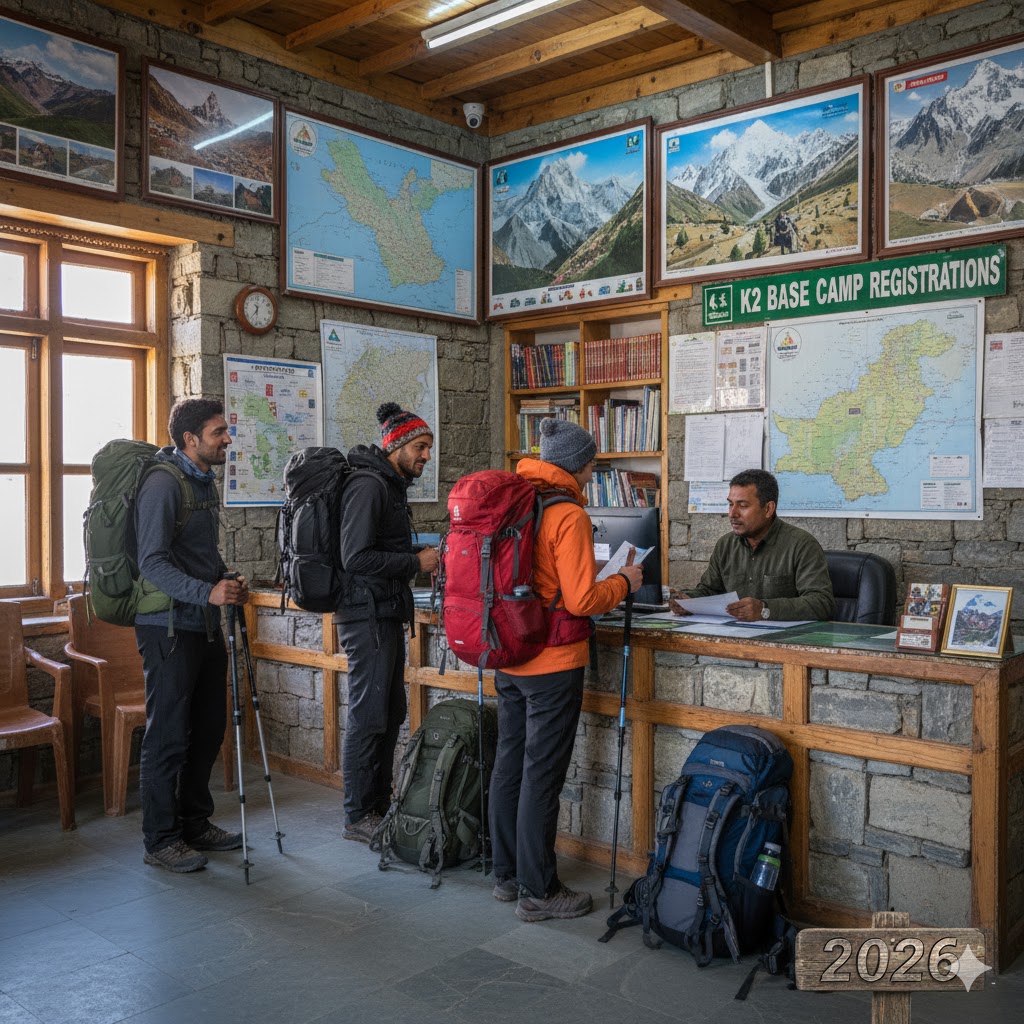
Source: Alpine Club of Pakistan.
Pro Tips from Veteran Mountaineers
We reached out to Pakistan’s leading trekking experts for their insights:
🗣️ “Don’t rush. The mountains will always be here — acclimatize and listen to your body.” — Samina Baig, First Pakistani woman to climb Everest.
🗣️ “Support local guides and buy supplies locally. It makes a difference.” — Ali Sadpara Foundation Representative.
🗣️ “Bring a good attitude. Nature rewards patience more than strength.” — Traverse Pakistan Team.
Significance: The collective wisdom of Pakistan’s mountaineers has shaped global respect for its trekking scene.
Tradition: Sharing stories by the campfire is how generations of Pakistani guides pass down knowledge.
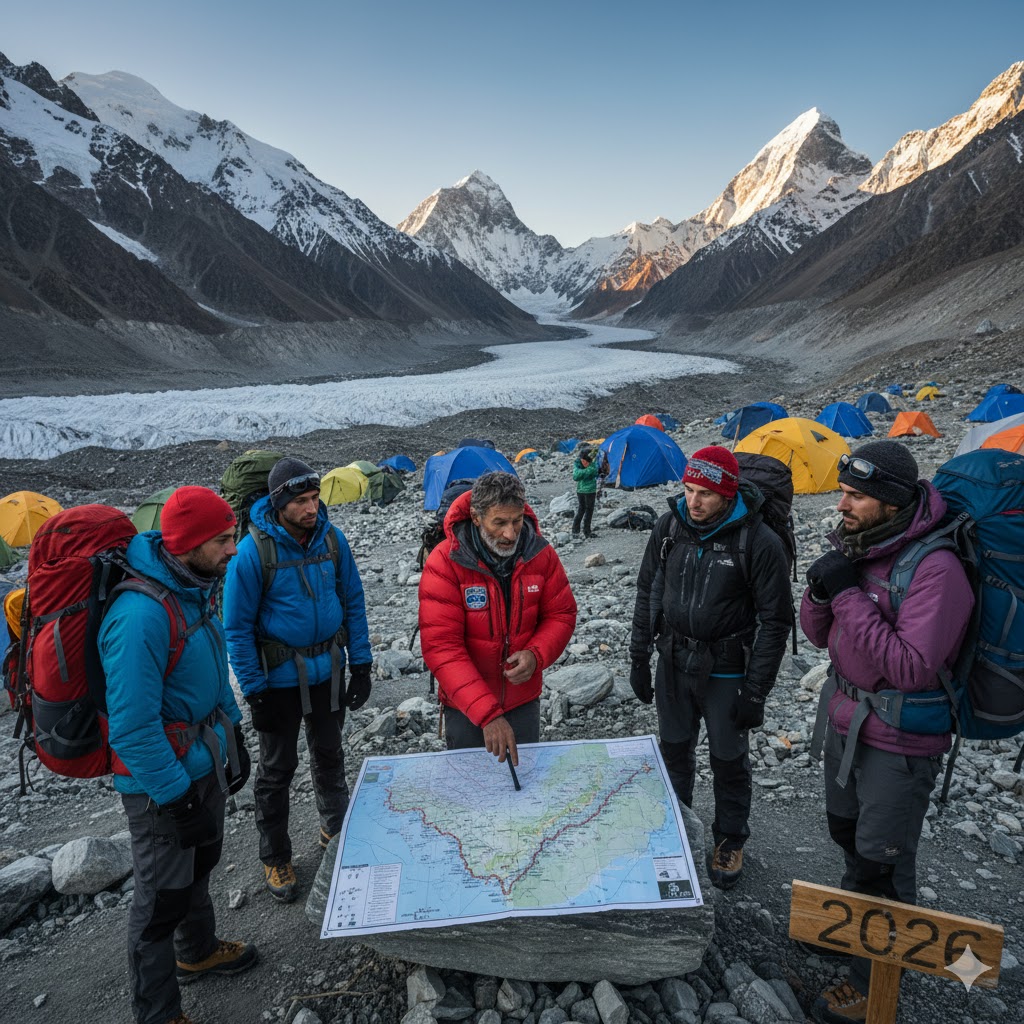
Traveler Guide:
From icy glaciers to green valleys, adventure treks in Pakistan offer an unmatched combination of nature, culture, and thrill. Whether you’re hiking the Karakoram’s rugged routes or the tranquil trails of Swat, Pakistan’s mountains are calling louder than ever in 2026.
Adventure seekers around the globe are now discovering what locals have always known — the true heart of the Himalayas beats in Pakistan.
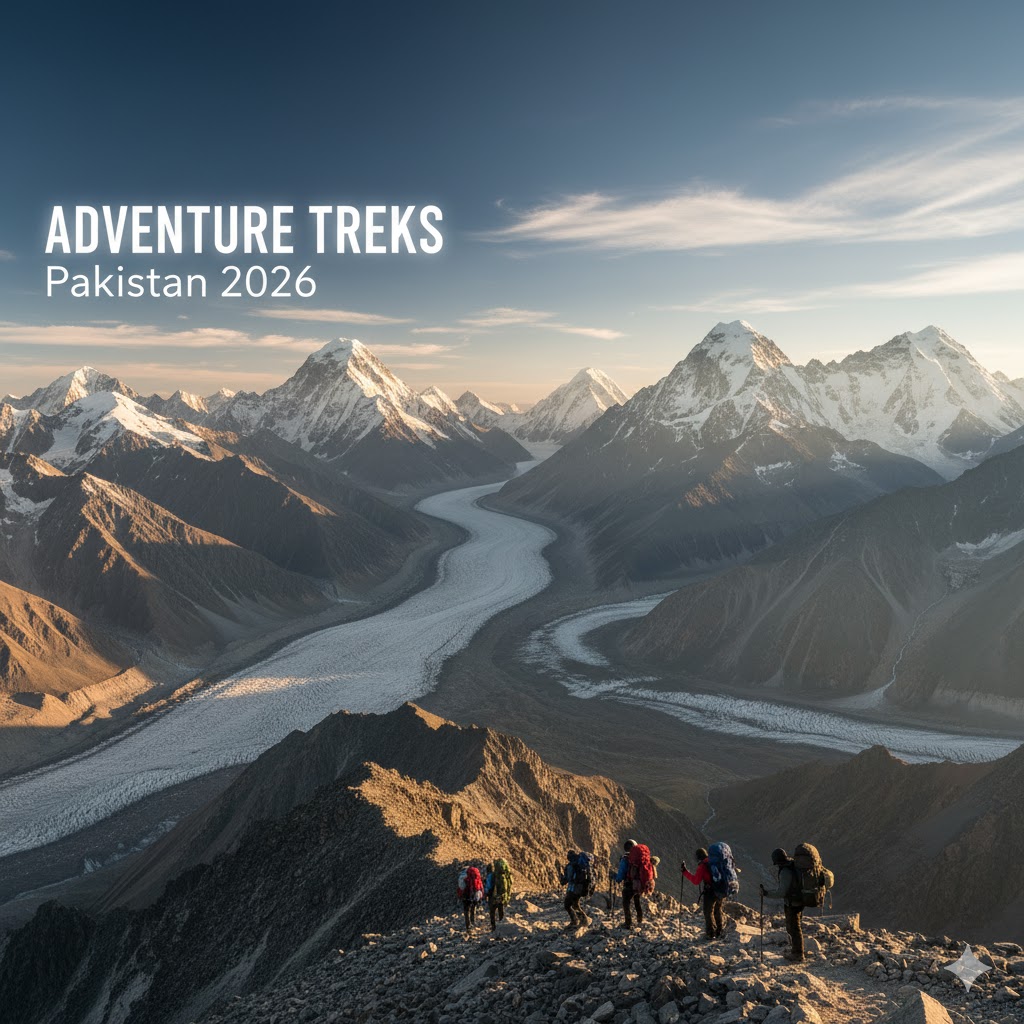
FAQs – Pakistan Adventure Trekking 2026
Q1. Which trek in Pakistan is best for beginners?
A: Fairy Meadows, Margalla Hills, and Naltar Valley are ideal for beginners seeking scenic, moderate hikes.
Q2. What is the most difficult trek?
A: K2 Base Camp is the toughest due to altitude and glacier terrain.
Q3. Are permits required for all treks?
A: Only treks near borders (K2, Batura, Karambar) require permits.
Q4. Is there internet access on mountain treks?
A: Only in major villages; satellite internet is available for expeditions.
Q5. Can foreign tourists easily book treks?
A: Yes, through certified agencies like Adventure Tours Pakistan and Apricot Tours.

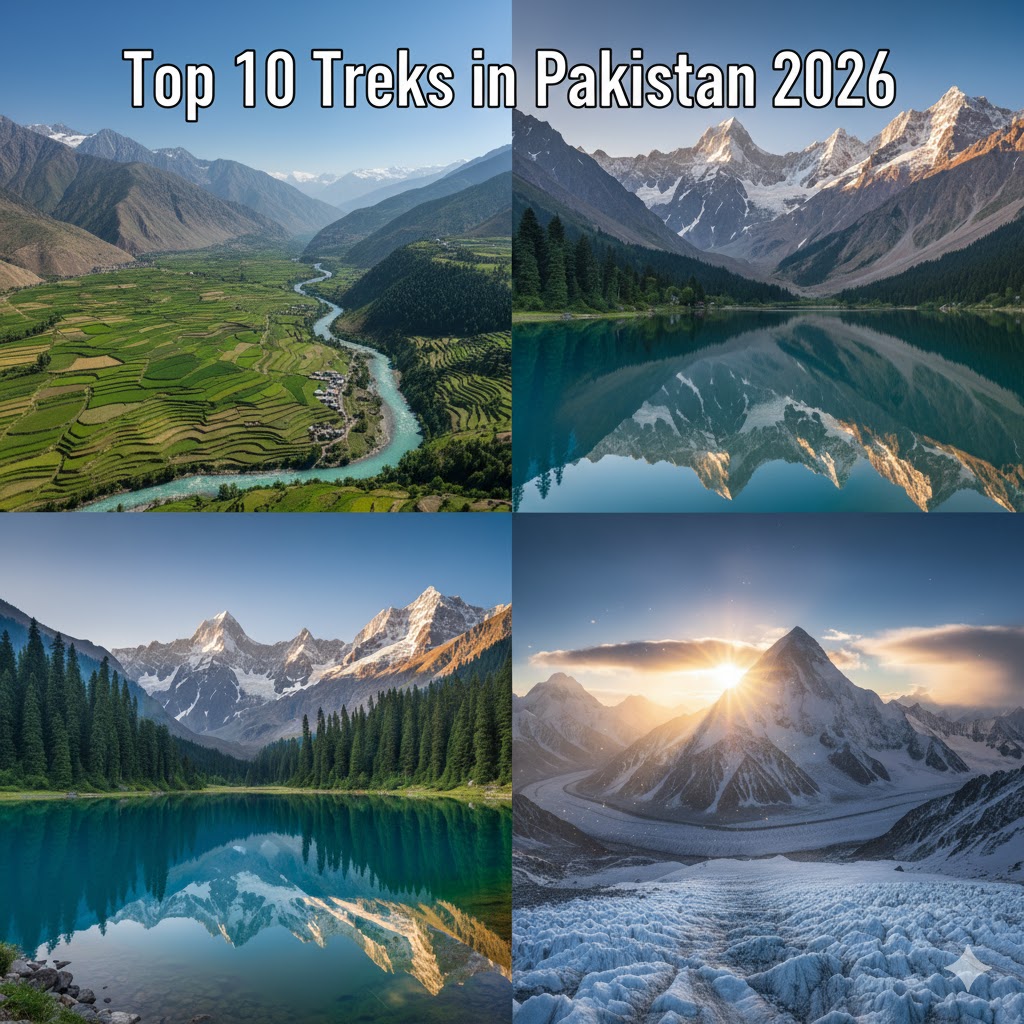


Pingback: Pakistan Trekking Cost 2026 Best Planning Budget Expert Guide
Pingback: Explore Kalash Cultural Adventures: 7 Rare Experiences 2025
Pingback: Naran Kaghan Travel Guide 2026: Ultimate Scenic & Adventure Tour
Pingback: Visit Hunza Valley Travel Guide 2026: Ultimate Adventure Tips
Pingback: EPIC World Festivals 2026: Jan–Dec Global Celebrations
Pingback: Best Life in the Mountains Pakistan 2026: Adventure Trails
Pingback: Discover Travel Spots Near Islamabad 2026 Hidden Gems
Pingback: Silk Road Heritage Pakistan 2025: Forgotten Buddhist Trails
Pingback: Skardu Hidden Gems Gilgit-Baltistan 2026 Explore Secrets